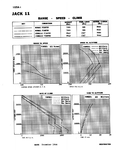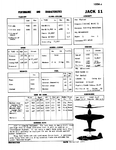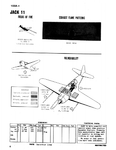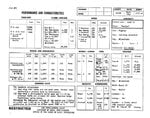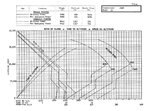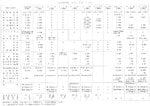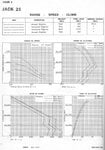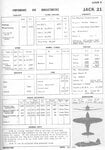J2M1:
Empty Weight: 2191kg
Loaded Weight: 2861kg
Wing Area: 20.05m2
Engine: MK4R-A Kasei 13
Take Off: 1430hp / 1400hp at 2700m / 1260hp at 6100m
-
Max Speed: (Military Power)
578km/h at 6000m
-
Rate of Climb: (Military Power)
Time to 6000m: ???
-
Turn Time:
16 seconds
-
Stall Speed: (At Sea Level, No Flaps)
149km/h IAS
-
Armament:
2x 7.7mm Type 97 (550 rounds per gun)
2x 20mm Type 99 Mk 2 (100 rounds per gun)
———————————————-
J2M2:
Empty Weight: 2348kg
Loaded Weight: 3210kg
Wing Area: 20.05m2
Engine: MK4R-A Kasei 23a
Take Off: 1820hp / 1575hp at 1800m / 1410hp at 4800m
-
Max Speed: (Military Power)
596km/h at 5450m
-
Rate of Climb: (Military Power)
Time to 6000m: 5:38
-
Turn Time:
17 seconds
-
Stall Speed: (At Sea Level, No Flaps)
157km/h IAS
-
Armament:
2x 7.7mm Type 97 (550 rounds per gun)
2x 20mm Type 99 Mk 2 (100 rounds per gun)
———————————————-
J2M3:
Empty Weight: 2490kg
Loaded Weight: 3440kg
Wing Area: 20.05m2
Engine: MK4R-A Kasei 23a
Take Off: 1820hp / 1575hp at 1800m / 1410hp at 4800m
-
Max Speed: (Military Power)
596km/h at 5450m
-
Rate of Climb: (Military Power)
Time to 6000m: 5:40
-
Turn Time:
18 Seconds
-
Stall Speed: (At Sea Level, No Flaps)
163km/h IAS
-
Armament:
2x 20mm Type 99 Mk 1 (190 rounds per gun)
2x 20mm Type 99 Mk 2 (210 rounds per gun)
———————————————-
J2M4:
Empty Weight: 2823kg
Loaded Weight: 3947kg
Wing Area: 20.05m2
Engine: MK4R-C Kasei 23c
Take Off: 1820hp / 1420hp at 9200m
-
Max Speed: (Military Power)
585km/h at 9200m
-
Rate of Climb: (Military Power)
Time to 10,000m: 19:30
-
Turn Time:
21 seconds
-
Stall Speed: (At Sea Level, No Flaps)
175km/h IAS
-
Armament:
2x 20mm Type 99 Mk 1 (190 rounds per gun)
2x 20mm Type 99 Mk 2 (150 rounds per gun)
———————————————-
J2M5:
Empty Weight: 2540kg
Loaded Weight: 3507kg
Wing Area: 20.05m2
Engine: MK4U-4 Kasei 26a
Take Off: 1820hp / 1510hp at 2800m / 1400hp at 6800m / 1310hp at 7200m
-
Max Speed: (Military Power)
615km/h at 6580m
-
Rate of Climb: (Military Power)
Time to 6000m: 6:20
Time to 8000m: 9:45
-
Turn Time:
19 Seconds
-
Stall Speed: (At Sea Level, No Flaps)
165km/h IAS
-
Armament:
2x 20mm Type 99 Mk 1 (190 rounds per gun)
2x 20mm Type 99 Mk 2 (210 rounds per gun)
———————————————-
J2M6:
Empty Weight: 2490kg
Loaded Weight: 3440kg
Wing Area: 20.05m2
Engine: MK4R-A Kasei 23a
Take Off: 1820hp / 1575hp at 1800m / 1410hp at 4800m
-
Max Speed: (Military Power)
590km/h at 5450m
-
Rate of Climb: (Military Power)
Time to 6000m: 5:40
-
Turn Time:
18 seconds
-
Stall Speed: (At Sea Level, No Flaps)
163km/h IAS
-
Armament:
2x 20mm Type 99 Mk 1 (190 rounds per gun)
2x 20mm Type 99 Mk 2 (210 rounds per gun)
Note:
Turn Time values are at 0-1000m, 360 sustained horizontal turn, No Flaps and at War Emergency Power. Turn Rate and stall speed value don't come from the sources. They are calculated by me. Etc Looking at J2M3, its turn rate should be pretty much identical to the Yak-3 (18 seconds) if they both do not use flaps. (Yak-3 has no combat flaps, the J2M3 does)
Sources:
• Mitsubishi Data, Jiro Horikoshi's book
• Specification and Performance of Service Airplanes of the IJN (10th September 1945)
Empty Weight: 2191kg
Loaded Weight: 2861kg
Wing Area: 20.05m2
Engine: MK4R-A Kasei 13
Take Off: 1430hp / 1400hp at 2700m / 1260hp at 6100m
-
Max Speed: (Military Power)
578km/h at 6000m
-
Rate of Climb: (Military Power)
Time to 6000m: ???
-
Turn Time:
16 seconds
-
Stall Speed: (At Sea Level, No Flaps)
149km/h IAS
-
Armament:
2x 7.7mm Type 97 (550 rounds per gun)
2x 20mm Type 99 Mk 2 (100 rounds per gun)
———————————————-
J2M2:
Empty Weight: 2348kg
Loaded Weight: 3210kg
Wing Area: 20.05m2
Engine: MK4R-A Kasei 23a
Take Off: 1820hp / 1575hp at 1800m / 1410hp at 4800m
-
Max Speed: (Military Power)
596km/h at 5450m
-
Rate of Climb: (Military Power)
Time to 6000m: 5:38
-
Turn Time:
17 seconds
-
Stall Speed: (At Sea Level, No Flaps)
157km/h IAS
-
Armament:
2x 7.7mm Type 97 (550 rounds per gun)
2x 20mm Type 99 Mk 2 (100 rounds per gun)
———————————————-
J2M3:
Empty Weight: 2490kg
Loaded Weight: 3440kg
Wing Area: 20.05m2
Engine: MK4R-A Kasei 23a
Take Off: 1820hp / 1575hp at 1800m / 1410hp at 4800m
-
Max Speed: (Military Power)
596km/h at 5450m
-
Rate of Climb: (Military Power)
Time to 6000m: 5:40
-
Turn Time:
18 Seconds
-
Stall Speed: (At Sea Level, No Flaps)
163km/h IAS
-
Armament:
2x 20mm Type 99 Mk 1 (190 rounds per gun)
2x 20mm Type 99 Mk 2 (210 rounds per gun)
———————————————-
J2M4:
Empty Weight: 2823kg
Loaded Weight: 3947kg
Wing Area: 20.05m2
Engine: MK4R-C Kasei 23c
Take Off: 1820hp / 1420hp at 9200m
-
Max Speed: (Military Power)
585km/h at 9200m
-
Rate of Climb: (Military Power)
Time to 10,000m: 19:30
-
Turn Time:
21 seconds
-
Stall Speed: (At Sea Level, No Flaps)
175km/h IAS
-
Armament:
2x 20mm Type 99 Mk 1 (190 rounds per gun)
2x 20mm Type 99 Mk 2 (150 rounds per gun)
———————————————-
J2M5:
Empty Weight: 2540kg
Loaded Weight: 3507kg
Wing Area: 20.05m2
Engine: MK4U-4 Kasei 26a
Take Off: 1820hp / 1510hp at 2800m / 1400hp at 6800m / 1310hp at 7200m
-
Max Speed: (Military Power)
615km/h at 6580m
-
Rate of Climb: (Military Power)
Time to 6000m: 6:20
Time to 8000m: 9:45
-
Turn Time:
19 Seconds
-
Stall Speed: (At Sea Level, No Flaps)
165km/h IAS
-
Armament:
2x 20mm Type 99 Mk 1 (190 rounds per gun)
2x 20mm Type 99 Mk 2 (210 rounds per gun)
———————————————-
J2M6:
Empty Weight: 2490kg
Loaded Weight: 3440kg
Wing Area: 20.05m2
Engine: MK4R-A Kasei 23a
Take Off: 1820hp / 1575hp at 1800m / 1410hp at 4800m
-
Max Speed: (Military Power)
590km/h at 5450m
-
Rate of Climb: (Military Power)
Time to 6000m: 5:40
-
Turn Time:
18 seconds
-
Stall Speed: (At Sea Level, No Flaps)
163km/h IAS
-
Armament:
2x 20mm Type 99 Mk 1 (190 rounds per gun)
2x 20mm Type 99 Mk 2 (210 rounds per gun)
Note:
Turn Time values are at 0-1000m, 360 sustained horizontal turn, No Flaps and at War Emergency Power. Turn Rate and stall speed value don't come from the sources. They are calculated by me. Etc Looking at J2M3, its turn rate should be pretty much identical to the Yak-3 (18 seconds) if they both do not use flaps. (Yak-3 has no combat flaps, the J2M3 does)
Sources:
• Mitsubishi Data, Jiro Horikoshi's book
• Specification and Performance of Service Airplanes of the IJN (10th September 1945)
Last edited:

